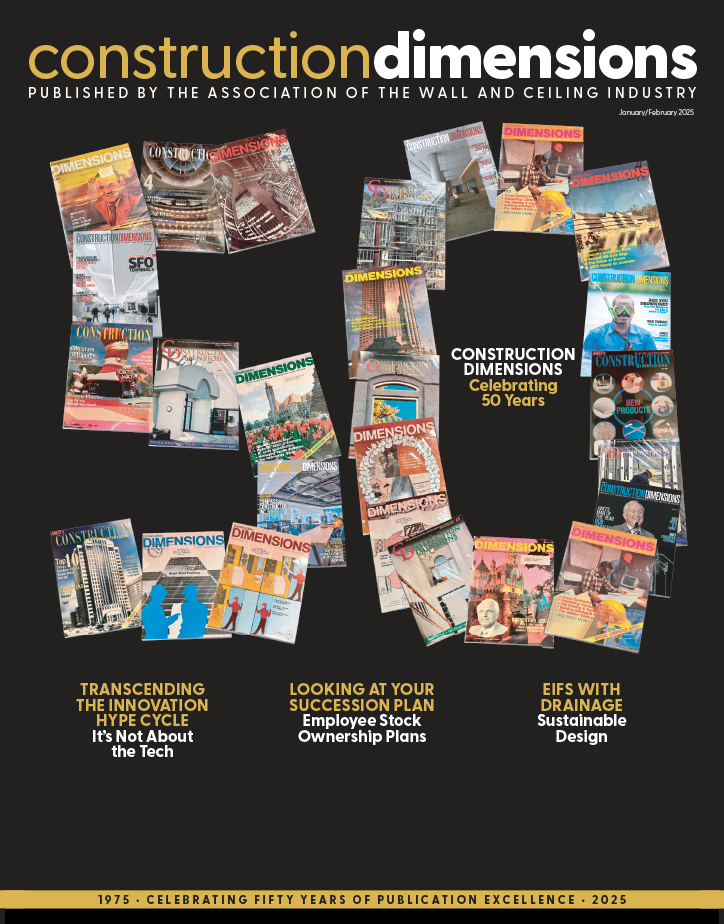The “Mission Impossible” movies and TV shows begin with Jim Phelps or Ethan Hunt receiving an assignment briefing: “Your mission, should you choose to accept it ….” Of course, it’s not really a choice. Phelps and Hunt could never admit a job is too big to do.
Frames and Finished Panels
Recently, I heard about a job underway at a university dormitory. The framer had pre-made rectangles out of 2 x 4s—12 inches tall and 3 feet wide and with cross-bracing. The work was done on a table in his shop—easy to do. Not so easy to do over a doorway on a job in progress. In the field, you’d have to cut multiple pieces multiple times, which is tedious, time-consuming and wasteful. Shop work is so much safer, cleaner and faster.
Maybe you could prefabricate more than just two-dimensional frames. How about finished exterior wall panels?
One AWCI member recently did a 20-story panelized project on a beach. They don’t have a panel shop, but they rigged in place someone else’s panels and applied some finishes.
Half of this building—30,000 square feet—was panelized. This AWCI member erected the finished exterior panels in six weeks. For the remaining 30,000 square feet, the firm field-applied the finish to concrete shear walls, balconies and other work at grade. It took eight months do that. There’s the value of prefabrication for you: six weeks versus eight months.
What’s Your Mission?
What role will you play in the prefabrication universe? You could oversee the engineering of panels. You could frame some panels. You could be a panel erector. You could just do the field-applied flashing-caulk-and-scaffold work required inevitably on every job since not everything is panelizable.
So, find your mission. Spread the word to architects, builders and developers about it. AWCI members handle steel stud framing, sheathing, air and water barriers, EIFS and other exterior finishes. Some handle all these categories, others handle only some. The point is, prefabrication involves a broad array of work very much within the general scope of what AWCI member contractors do.
Are most of you doing off-site work? Yes. The literature suggests that because of today’s manpower shortage and the pressures to save time, cut waste and deliver quality, prefab may provide some answers.
Labor savings
Many companies fabricate interior partition walls for buildings. They’re not cutting and fitting pieces on a job site. They’re cutting studs and screwing together panels with jigs in controlled environments with maybe one-tenth of the fastening effort of stick-building.
Time savings
Rigging prefabricated finished exterior panels in place requires no exterior scaffolding. That’s safer for all.
Waste control
Waste is nominal in a shop. But instead of having 40 dumpster loads of debris on the job site, the prefabricated job has maybe just a few, or even one.
Quality control
Pieceworkers want to work fast to make money. They’re less concerned about quality. But a plant has jigs. Studs go into the jigs with a perfect fit every time. And a QC guy is watching and measuring all day long. But in the field, he’s not going up on a swing scaffold 10 stories in the air to check how square the window openings are, right?
It’s Your Responsibility
More and more, we’re moving away from workers hammering and screwing things on the job site. So, if you’re a stick framer only right now, why not chose to accept the mission of prefabrication? Try one of the suggestions in the article, “Prefabrication: Have You Jumped on the Bandwagon?” found on page 26 in this issue of AWCI’s Construction Dimensions.
And if you want to build a plant, just plan accordingly. I hear you’ll need $2 million to invest in a plant that produces finished exterior wall panels—more if you add in overhead cranes, forklifts and specialized environmental controls.
Maybe you have the funds. Or maybe a bank will support you. You have a choice. But like Ethan Hunt, why not just accept the opportunity?
Mark L. Johnson writes for the walls and ceilings industry. He can be reached via Linkedin.





